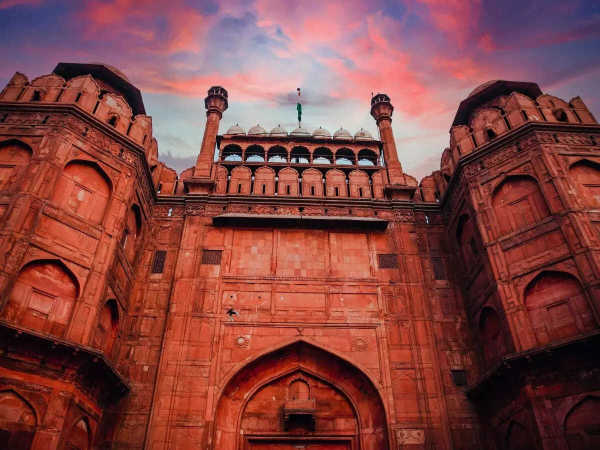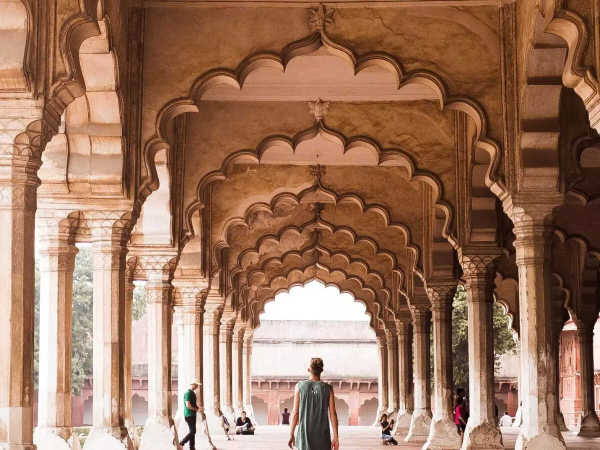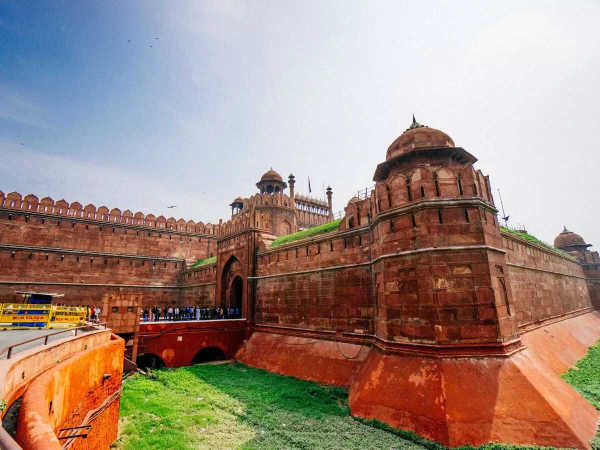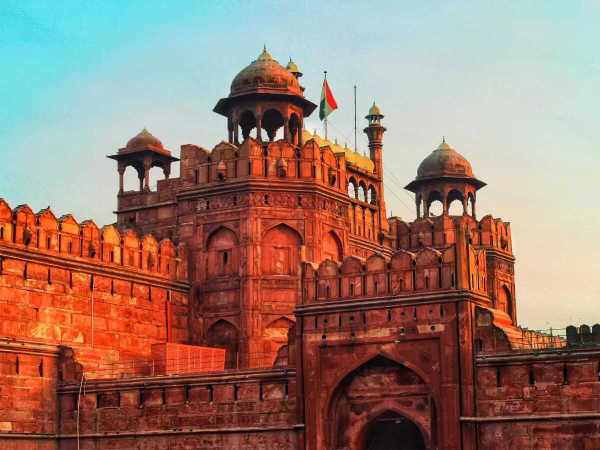Why the Red Fort was once white; more interesting facts to know about Delhi's Lal Qila
Red Fort , also known as Lal Qila , is a historic fort in Delhi which was built by Mughal Emperor Shah Jahan in the 17th century. The fort will definitely leave you awestruck with its architectural beauty and is known for its red stone walls. The architecture is a mix of Persian, Timurid, and Indian styles. This fort in Old Delhi, near Chandni Chowk, is also a UNESCO World Heritage Site and a great symbol of India’s rich history and independence.
On this note, let’s have a look at some unique facts about Red Fort that will definitely leave you astonished:
Construction
 The construction of this fort started in 1638, which is the Islamic month of Muharram, under Emperor Shah Jahan. This fort took almost a decade to get completed, and the city of Shahjahanabad was built around it. This fort was constructed because the capital of Shah Jahan was being shifted from Agra to Delhi.
The construction of this fort started in 1638, which is the Islamic month of Muharram, under Emperor Shah Jahan. This fort took almost a decade to get completed, and the city of Shahjahanabad was built around it. This fort was constructed because the capital of Shah Jahan was being shifted from Agra to Delhi.
The Fort Was Originally White
 This fort is quite famous worldwide for having red sandstone, but this fort was actually white in color as it was covered in white lime plaster. When the plaster got eroded, the British decided to paint it red to preserve the structure, which gave way to the name ‘Red Fort’.
This fort is quite famous worldwide for having red sandstone, but this fort was actually white in color as it was covered in white lime plaster. When the plaster got eroded, the British decided to paint it red to preserve the structure, which gave way to the name ‘Red Fort’.
Pre-Mughal Eras
 There have been excavations at the Red Fort that revealed some artefacts such as Ochre Colored Pottery culture dated between 2600–1200 BC. These excavations show that this region was inhabited a millennia before Shah Jahan built the fort. There have been similar findings at other areas of India as well, such as Haryana and Uttar Pradesh, as they depict ancient settlement patterns.
There have been excavations at the Red Fort that revealed some artefacts such as Ochre Colored Pottery culture dated between 2600–1200 BC. These excavations show that this region was inhabited a millennia before Shah Jahan built the fort. There have been similar findings at other areas of India as well, such as Haryana and Uttar Pradesh, as they depict ancient settlement patterns.
A Covered Royal Bazaar
Chatta Chowk , located in the Red Fort, is a covered market with 32 arched shops that sold items like silks, gems, and jewelry. This kind of indoor bazaar was one of a kind in Mughal India, which used to serve the imperial elite and court visitors within the Red Fort walls, as mostly the Mughal bazaars were open-air markets.
Invisible Security System
 Red Fort is considered to have a unique design where approaching visitors could be detected from certain chambers with the help of echoes, which used to help court officials to hear who is entering the court even before they entered it.
Red Fort is considered to have a unique design where approaching visitors could be detected from certain chambers with the help of echoes, which used to help court officials to hear who is entering the court even before they entered it.
Trial at Home
 This architectural marvel was home to the last Mughal emperor, ‘Bahadur Shah Zafar’, who was tried for treason by the British in Diwan-i-Khas, his own reception hall, after the revolt of 1857, but ultimately was sent to exile in Rangoon, now known as Myanmar.
This architectural marvel was home to the last Mughal emperor, ‘Bahadur Shah Zafar’, who was tried for treason by the British in Diwan-i-Khas, his own reception hall, after the revolt of 1857, but ultimately was sent to exile in Rangoon, now known as Myanmar.
Entrance of Red Fort
The main gate of Red Fort is known as Lahori Gate and is one of the 14 gates of the city of Shahjahanabad, now known as Old Delhi. Every year, the Prime Minister of India hoists the national flag from the Lahori Gate.
The Koh-i-Noor and Peacock Throne Was Once a Part of It
Reportedly, the Koh-i-Noor diamond , now in London, was once placed on the beautiful Peacock Throne, which was placed inside the Diwan-i-Khas in the Red Fort. Both of these beautiful ornaments were taken from India.
So next time you visit Red Fort, you’ll want to look at it from a new perspective!
On this note, let’s have a look at some unique facts about Red Fort that will definitely leave you astonished:
Construction
 The construction of this fort started in 1638, which is the Islamic month of Muharram, under Emperor Shah Jahan. This fort took almost a decade to get completed, and the city of Shahjahanabad was built around it. This fort was constructed because the capital of Shah Jahan was being shifted from Agra to Delhi.
The construction of this fort started in 1638, which is the Islamic month of Muharram, under Emperor Shah Jahan. This fort took almost a decade to get completed, and the city of Shahjahanabad was built around it. This fort was constructed because the capital of Shah Jahan was being shifted from Agra to Delhi.
The Fort Was Originally White
 This fort is quite famous worldwide for having red sandstone, but this fort was actually white in color as it was covered in white lime plaster. When the plaster got eroded, the British decided to paint it red to preserve the structure, which gave way to the name ‘Red Fort’.
This fort is quite famous worldwide for having red sandstone, but this fort was actually white in color as it was covered in white lime plaster. When the plaster got eroded, the British decided to paint it red to preserve the structure, which gave way to the name ‘Red Fort’.
Pre-Mughal Eras
 There have been excavations at the Red Fort that revealed some artefacts such as Ochre Colored Pottery culture dated between 2600–1200 BC. These excavations show that this region was inhabited a millennia before Shah Jahan built the fort. There have been similar findings at other areas of India as well, such as Haryana and Uttar Pradesh, as they depict ancient settlement patterns.
There have been excavations at the Red Fort that revealed some artefacts such as Ochre Colored Pottery culture dated between 2600–1200 BC. These excavations show that this region was inhabited a millennia before Shah Jahan built the fort. There have been similar findings at other areas of India as well, such as Haryana and Uttar Pradesh, as they depict ancient settlement patterns.
A Covered Royal Bazaar
Chatta Chowk , located in the Red Fort, is a covered market with 32 arched shops that sold items like silks, gems, and jewelry. This kind of indoor bazaar was one of a kind in Mughal India, which used to serve the imperial elite and court visitors within the Red Fort walls, as mostly the Mughal bazaars were open-air markets.
Invisible Security System
 Red Fort is considered to have a unique design where approaching visitors could be detected from certain chambers with the help of echoes, which used to help court officials to hear who is entering the court even before they entered it.
Red Fort is considered to have a unique design where approaching visitors could be detected from certain chambers with the help of echoes, which used to help court officials to hear who is entering the court even before they entered it.
Trial at Home
 This architectural marvel was home to the last Mughal emperor, ‘Bahadur Shah Zafar’, who was tried for treason by the British in Diwan-i-Khas, his own reception hall, after the revolt of 1857, but ultimately was sent to exile in Rangoon, now known as Myanmar.
This architectural marvel was home to the last Mughal emperor, ‘Bahadur Shah Zafar’, who was tried for treason by the British in Diwan-i-Khas, his own reception hall, after the revolt of 1857, but ultimately was sent to exile in Rangoon, now known as Myanmar.
Entrance of Red Fort
The main gate of Red Fort is known as Lahori Gate and is one of the 14 gates of the city of Shahjahanabad, now known as Old Delhi. Every year, the Prime Minister of India hoists the national flag from the Lahori Gate.
The Koh-i-Noor and Peacock Throne Was Once a Part of It
Reportedly, the Koh-i-Noor diamond , now in London, was once placed on the beautiful Peacock Throne, which was placed inside the Diwan-i-Khas in the Red Fort. Both of these beautiful ornaments were taken from India.
So next time you visit Red Fort, you’ll want to look at it from a new perspective!
Read more









